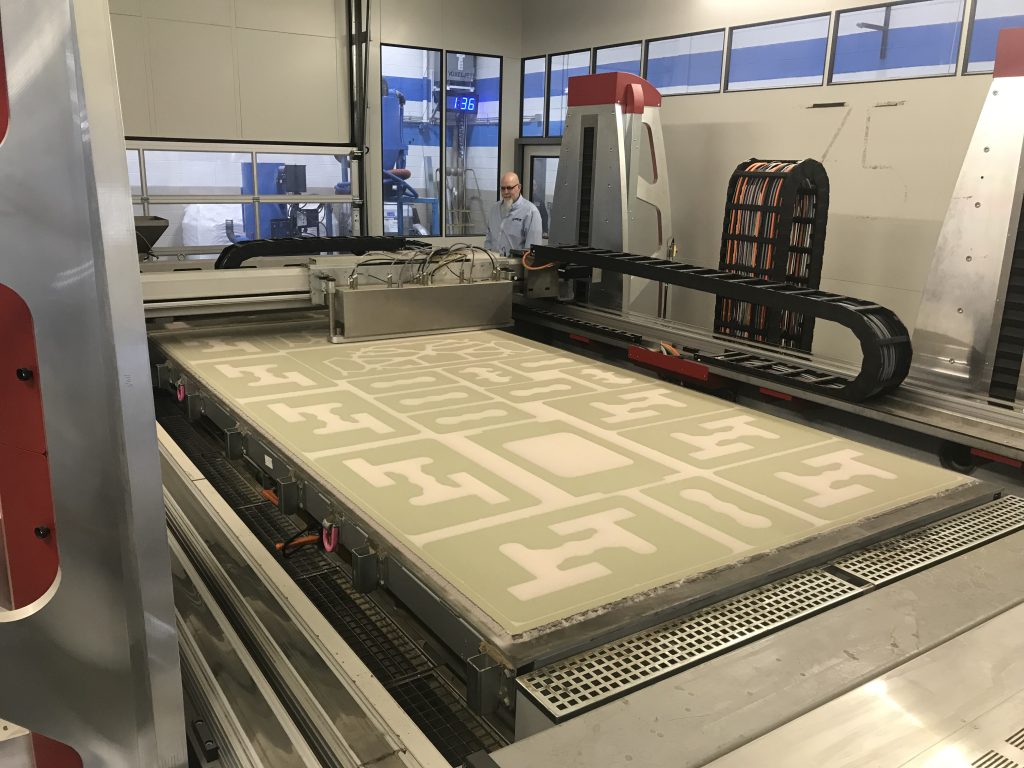Binder jet 3D printer manufacturer Voxeljet and Tooling & Equipment International (TEI) have expanded their collaboration with the sale of a third VX4000 3D printer to TEI.
As a vendor to General Motors, TEI employs the world’s largest 3D sand printer to develop cast cores for the series production of massive, weight-saving structural parts for the Cadillac CELESTIQ. OEM manufacturers can realize totally fresh, function-optimized designs by incorporating 3D printing into parts development and construction. Vendors profit from the rapid and adaptable incorporation of 3D printed cores into established manufacturing lines.
“We are pleased to have TEI as a strong partner and user of sand 3D printing in the US. The purchase of the third VX4000 printer builds on previous system installations at TEI’s corporate site in Livonia, Michigan, and enables the company to grow rapidly and deliver unique projects like this,” said Michael Dougherty, Managing Director at voxeljet America Inc.

Casting large-format structural components with Voxeljet and TEI
Since 2018, TEI, a leader in highly complex castings for the engineering and manufacturing industries, has collaborated with voxeljet. What began as a three-year volume agreement for more than 500,000 liters of 3D printed sand became a big success for both businesses.
TEI claims it is the only US-based business that owns three voxeljet VX4000 3D printers, which have a build volume of 4 x 2 x 1 meter making them the world’s largest 3D sand printers. TEI has increased its AM capacity to up to 2.5 million liters per year with the addition of its third VX4000. This allows the US firm to pursue more technically challenging projects, like series manufacturing of lightweight parts for the underbody structure of the all-electric Cadillac CELESTIQ.
Voxeljet claims each casting replaces up to 40 components. The novel underbody structure comprises six large highly precise sand-cast aluminum parts. TEI uses AM technologies in production for all internal cores to realize complicated structures as “economically and lightly” as possible. This enables the incorporation of stiffening characteristics into the hollow sections, that are not financially viable in traditional processes. Each vehicle underbody is constructed using 51 additively manufactured sand cores. These are printed on the VX4000 printers, which can print hundreds of internal cores for multiple vehicle sets in a single night. The cores are evened after printing, covered with a fire-resistant coating, put in sand molds, and ultimately cast employing a low-pressure filling process. When compared to a usually stamped construction, each of the six castings decreases the total number of components by 30 to 40.
Because each structural part has completely machined interfaces, the six castings can be accurately assembled while maintaining very tight tolerances for assembly fabrication. Short delivery times for weight and design-optimized lightweight parts are rendered possible by VX40000 3D printers. Large-format mold and core printing on the VX4000 3D printers make production simpler, quicker, and more cost-effective when compared to traditional manufacturing. Substantially fewer parts must be manufactured, simplifying and speeding up assembly work.
“By eliminating tools and taking advantage of the large build volume of the VX4000 printers, we can significantly reduce delivery times and produce lightweight components with optimized topologies. This would not be possible in a conventional way,” said Oliver Johnson, President of TEI.
Furthermore, 3D sand printing allows for totally new designs and lightweight structures. Consequently, geometrically optimized parts are produced, which are critical in the aerospace and automotive sectors. What is critical for supplier integration: With the VX4000 3D printers, new function-optimized designs can be realized effortlessly and quickly, and printed cores can be effortlessly incorporated into current production, claims Voxeljet.
“Together, we will further establish additive manufacturing technology in industrial manufacturing and intensify our collaboration. We are proud to support the company with our unique 3D printing technology and to show once again that our printed casting technology is entering production and enabling unprecedented designs,” added Dougherty.

Companies promoting sand 3D printing
Previously, architectural design firms Precht and Mamou-Mani Architects used 3D printing to create a pair of implementations in Saudi Arabia. The first installation, Sandwaves, employs a sand 3D printing technique and features lattice structures woven in a ribbon-like pattern. The second component is a stacked cube set called Pixel Gate, which was 3D printed employing a standard extrusion-based method.
Furthermore, industrial 3D printer provider ExOne, announced the debut of the S-Max Pro, a novel industrial sand 3D printer, at the 2019 GIFA International Foundry Trade Fair in Dusseldorf, Germany. ExOne also announced an alliance with Siemens, in addition to the S-Max Pro. Siemens’ Digital Enterprise Portfolio of software and automation technology was anticipated to be integrated into ExOne’s 3D printer as part of their collaboration. The S-Max Pro is intended for prototyping as well as industrial series production, with an emphasis on speed, reliability, and accuracy. Siemens’ Digital Enterprise portfolio was implemented to assist the system in harnessing the advantages of Industry 4.0, to the profit of industrial users in the foundry, aerospace, automobiles, energy, and other markets.
What does the future of 3D printing for the next ten years hold?
What engineering challenges will need to be tackled in the additive manufacturing sector in the coming decade?
To stay up to date with the latest 3D printing news, don’t forget to subscribe to the 3D Printing Industry newsletter or follow us on Twitter, or like our page on Facebook.
While you’re here, why not subscribe to our Youtube channel? Featuring discussion, debriefs, video shorts, and webinar replays.
Are you looking for a job in the additive manufacturing industry? Visit 3D Printing Jobs for a selection of roles in the industry.
Feature image shows the build space of the VX4000 during the printing process. Image via TEI.



